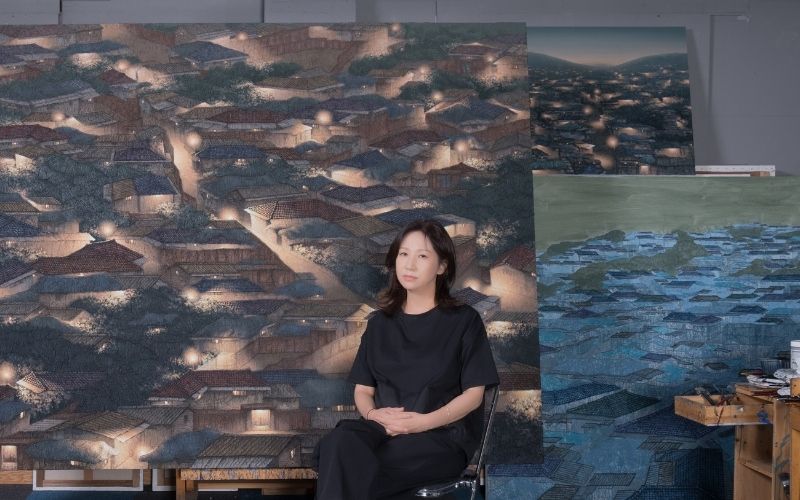Joung Young-Ju’s cityscapes evoke the quiet complexity of Seoul, where light and shadow dance on familiar yet distant streets. Her paintings, bathed in the soft glow of twilight, pull us into urban scenes that feel both intimate and vast, hinting at lives lived just out of sight. Born in 1970, Young-Ju spent her childhood drawing the buildings in her village before leaving Korea to study Fine Art in Paris. Upon returning, she was struck by the view of downtown Seoul from Nam Mountain, a moment that would become a defining influence on her work.

Her unique portrayal of Seoul resonates deeply with many renowned Korean artists, who find themselves inspired by her paintings. Through her art, Young-Ju evokes a sense of longing for home, allowing others to reconnect with their roots and memories of Korea. With a technique that blends traditional Korean paper with contemporary brushwork, her art reflects both history and transformation. Through textured surfaces and subtle lighting, Young-Ju captures the emotional essence of Seoul—its spaces, its people, and the quiet beauty found in the transition from day to night. In this interview, she reflects on the inspirations behind her paintings and the memories that breathe life into her work..
This interview took place in writing via email between December 19, 2024, and March 11, 2025.
Could you please briefly introduce yourself?
I am an artist who reconstructs old landscapes in Seoul through memory and imagination.

How does your childhood experience in your hometown influence your artistic style and choice of subjects?
When I was a child, I grew up in a neighborhood of ordinary people in Seoul. At that time, Seoul was very different from what it is now. I lived a very poor and difficult life, but there was a warm sense of affection and humanity among the villagers. This has become the theme of my work, which I strive to express today. The rapid development of Korea is admirable, but many things are being lost because of it.
Your paintings do not feature human figures, yet they convey a strong sense of life through houses and light. How do you create this feeling of presence without depicting people?
The vitality of the work may come from the blazing shapes and the light of the crumpled paper. The light gives me a strong sense of hope and life.

How long does it typically take you to complete a painting, and what is your creative process like?
My work requires a lot of labor, so it takes at least a month, sometimes even up to two months. I find old houses that still remain here and there between the tall buildings in Seoul, take pictures of them, recall my childhood memories, and incorporate my imagination to sketch them. Then, I attach pieces of paper to create the form and add color. Finally, I paint the light to breathe life and hope into the piece.
What unique qualities does hanji paper bring to your work, and how do you feel it connects to your cultural identity?
I had the experience of living in the countryside as a child. The doors of the houses there were made of wooden frames with paper attached to them, and that paper was a type of hanji. So, hanji feels very familiar to me. For me, it serves as both a nostalgic reminder of rural life and a material for expressing my identity. My work, which combines hanji with Western paints, may also be connected to my nomadic way of life.

Your captivating artworks have attracted the attention of many esteemed Korean artists worldwide. How have they responded to your unique vision?
I think they probably always miss their hometown. People living abroad always feel like outsiders, so they want to find their identity. I was the same... I think they might find sympathy in my works, which are both Korean and exotic.
How do you see your art evolving in the future? Are there any new themes or techniques you plan to explore?
My current area of interest is the environment and nature. Nature and the seasons are strongly reflected in my work. I want to create pieces on the theme of disappearing nature. I am always contemplating and experimenting with both themes and techniques.
Lastly, could you kindly share some details about your upcoming exhibitions or new projects?
While also participating in art fairs like Art Basel and Frieze, this year I will be working on preparations for my solo exhibition in New York, which will be held next year.
How about this article?
- Like5
- Support0
- Amazing2
- Sad0
- Curious0
- Insightful0


